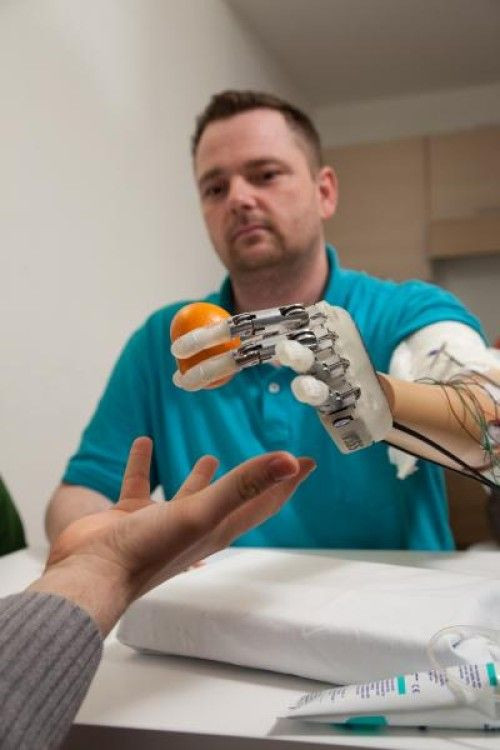In Touch With Reality: Scientists Give Amputee World's First Prosthetic Touch Capable Hand

Dennis Aabo Sørensen’s life changed nine years ago when he lost his left hand in a fireworks accident, and it changed again on Wednesday. The Danish man became the first person to “feel” using a prosthetic hand. Using a series of electrodes surgically connected to living nerves in the remaining part of his left arm, the sensory-enhanced robotic hand can send, in real time, information that Sørensen’s brain interprets as touch.
"I could feel things that I hadn't been able to feel in over nine years," said the 36-year-old amputee. Silvestro Micera and his team at École Polytechnique Fédérale de Lausanne (EPFL) in Switzerland and the Sant'Anna School of Advanced Studies (SSSA) in Italy developed the revolutionary bionic hand. Micera’s research was published Wednesday, Feb. 5, in the journal Science Translational Medicine.
The breakthrough represents a shift in how prosthetics have approached the complicated sense that is touch. A DARPA research project looking at replicating touch has previously focused on contact location, or what part of the skin was touched. “The animals [monkeys] were trained to identify several patterns of physical contact with their fingers,” said Sliman Bensmaia, professor at the University of Chicago. “Researchers then connected electrodes to areas of the brain corresponding to each finger and replaced physical touches with electrical stimuli delivered to the appropriate areas of the brain. The result: The animals responded the same way to artificial stimulation as they did to physical contact.”
But Sørensen’s prosthetic hand is able to tell not only what shape the object is but also the solidity. "When I held an object, I could feel if it was soft or hard, round or square,” stated Sørensen. Several tests were performed while Sørensen was blindfolded. With the new hand, he was able to receive feedback in the form of pressure sense and could tell the shape and consistency of the object he was holding.
Micera was able to achieve the tactile feedback by first measuring tension in artificial tendons, the ones that control the prosthetics movements, and converting the measurements into electrical outputs. However, that only creates raw data. Micera and his team fine-tuned the data by using computer algorithms, creating something that the human nervous system can interpret. "This is the first time in neuroprosthetics that sensory feedback has been restored and used by an amputee in real-time to control an artificial limb," Micera says.
The scientists were initially concerned about Sørensen’s nerves and whether they would be responsive enough to pass the refined impulse signals from the prosthesis. "We were worried about reduced sensitivity in Dennis's nerves since they hadn't been used in over nine years," says Stanisa Raspopovic, first author and scientist at EPFL and SSSA. However, after Sørensen recovered from surgery, those concerns disappeared.
However exciting the breakthrough may be, Micera and his team’s work is in preliminary trials. Sørensen has been the only test subject currently. He was chosen due to the nature of his injury and his physical strength, which the study cites as an asset. "I was more than happy to volunteer for the clinical trial, not only for myself, but to help other amputees as well,” Sørensen said.
The trial took place over a two month period at the beginning of last year. Sørensen underwent surgery on Jan. 26, 2013. Preliminary testing on the transneural electrodes took 19 days. Once the electrodes passed those tests, the scientists connected the prosthetic hand to Sørensen daily for a week, giving the Danish family man the first prosthetic touch in the world.
Further research and development still needs to take place to bring the prosthesis into the commercial world, but Micera, his team and Sørensen have taken the first steps toward giving amputees a tactile response again.
© Copyright IBTimes 2024. All rights reserved.





















